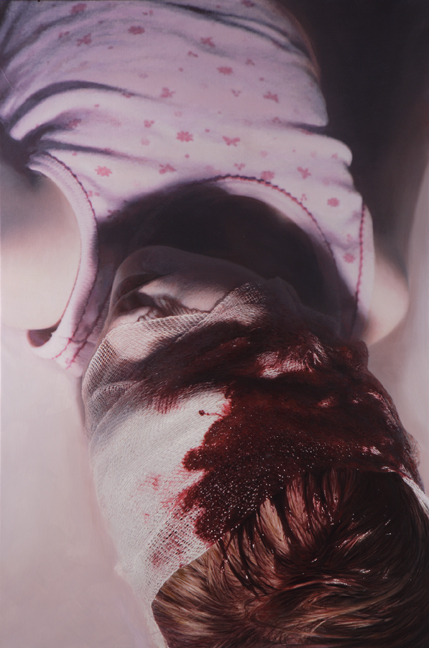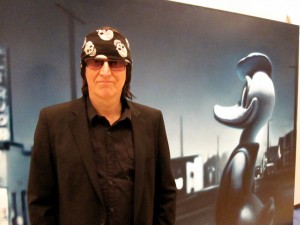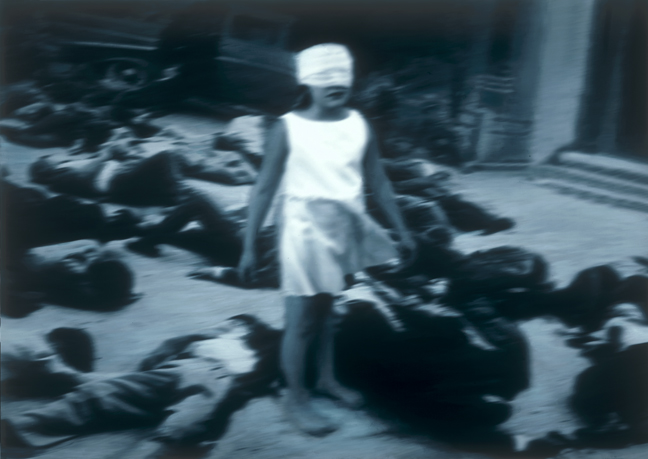Broken Dreamers
Posted on February 3, 2011 – 2:23 AM | by OldManFosterBy Tim Foster
Stunning.
It’s the best single word to describe Inferno of the Innocents, the exhibit of work by Austrian artist Gottfried Helnwein that opened at the Crocker on January 29th.
Let’s start with the obvious: Helnwein is one hell of a painter. His massive, photo-like pictures of vulnerable children are breathtaking, both in the often disturbing nature of the imagery and in the artist’s virtuostic ability to mimic life with pigment (a mixture of oil and acrylic) and brush. Each bloodied hair seems utterly real; pale, near-translucent skin seems to cover actual flesh, and the eyes of Helnwein’s child subjects are damp and deep. But, while Helnwein is a master painter, his skill serves only to bring his carefully crafted scenes to fruition; it is the artist’s combination of sophisticated brushwork and calculated, provocative imagery that defines his art.
Inferno of the Innocents focuses – as does most of Helnwein’s work – on grotesque themes, often involving injured or disfigured children. Viewers familiar only with the artist’s Andrew Wyeth-like portraits of young girls will be shocked; those quiet and beautiful scenes are the outsiders in Helnwein’s catalog. Three paintings in the show – graphic depictions of a bloody-headed young girl – are particularly loaded at this moment; they can’t help but evoke Christina Taylor Green, the nine year old girl killed in the recent mass shooting in Tucson.
Shock has been an essential component of Helnwein’s work since the beginning. In art school in 1966 Helnwein began enacting performances in which he cut himself bloody with razors and etching tools. Later, while at Vienna’s University of Visual Art (the same school that rejected a young Adolph Hitler) he worked on performance pieces involving bandaged children in public places. Photographs of these performances inspired some of his early paintings, watercolors of disfigured toddlers. People reacted – strongly. Though the images were meant to be disturbing, Helnwein was surprised at the intensity of the reactions. “I didn’t expect [that],” he says. “I thought, ‘who’d care about this little watercolor?’”
The almost cartoonishly dark themes Helnwein explores are rooted in the artist’s bleak childhood in postwar Vienna. Helnwein felt completely isolated. “The world I lived in, I didn’t want to be there. I thought, ‘these people are strangers,’ even my parents…. I didn’t feel I belonged there.”
Helnwein describes his discovery of Walt Disney comic books as his salvation – his first glimpse of a world in which he actually wanted to live. He cites Carl Barks’ Donald Duck comics as a lifelong inspiration – a debt he has repaid by bringing Disney characters into his work many times over the years. A large and ominous Mickey Mouse looms out of Annunciation (Mouse 12), and Donald Duck features in several of the paintings on display in the show.
A fascination with comics, and his willingness to accept them as ‘Art,’ is one of several traits that aligns him with the Pop Surrealist movement and Juxtapoz Magazine. Though Helnwein was making work for decades before Juxtapoz existed, he sees the magazine, and the narrative artists it champions, as kindred spirits. In contrast, he has little patience for conceptually-driven art like that of Jeff Koons and Damien Hirst. “I don’t think art should be like an introverted game for intellectuals,” he says. “It should be something that a human being, by looking at or listening to, should immediately be able to feel something…”
Immediacy is key in Helnwein’s work. His paintings are carefully conceived to ‘grab’ the viewer, and to provoke a reaction. His experience with those early watercolors was not forgotten, and it is no coincidence that his favorite subject matter – vulnerable children, the injured/handicapped, pop and movie stars, and Nazis (especially Nazis) – come pre-loaded with an emotional response. For Helnwein, life in Hitler’s aftermath (he was born in 1948) called for outrage, not subtlety.
“I didn’t see it with my own eyes, but don’t forget, in that country 6 million Jews were killed, 500,000 gypsies were killed, gay people went to concentration camps… you cannot cause so much pain and death and not feel that. Even if you come later, you feel that, or I felt it, at least… [But] you couldn’t communicate to anybody… [I asked myself] ‘Why would people do that to other people?’ That was the reason I eventually became an artist.”
The Holocaust has been a touchstone for many artists from Teutonic countries, including Gerhard Richter, to whom Helnwein is inevitably compared. The comparison has to be difficult for Helnwein; Richter is on nearly every critic’s short list of the world’s greatest living artists. Helnwein is on Sean Penn’s.
I discovered that fact while doing online research for this article. Helnwein has a vast and meticulously-kept web presence, and Google searches will almost invariably lead back to one of his own sites. I also learned that the artist was referred to as “one sick motherfucker” by no less an authority than Robert Crumb, and that German rockers the Scorpions used a Helnwein painting for the cover of their 1982 album, Blackout. But perhaps the most intriguing kernel of Helnweinia was nowhere to be found on the artist’s official site [correction: it’s there, but hard to find].
I did the mental equivalent of a spit-take when I realized that Helnwein had painted Boulevard of Broken Dreams, the all-too-familiar parody of Edward Hopper’s Nighthawks in which the lonely diner is populated by James Dean, Humphrey Bogart, Elvis Presley and Marilyn Monroe. I was so stunned that I immediately began to wonder if he had also painted Sitting Duck, a picture of a cartoon duck in a beach chair looking at two bullet holes in the wall next to him… but no – wrong duck. Still, discovering that Helnwein had created a picture that is the absolute epitome of kitsch – a work so godawful that it’s hard to actually think of it as anything other than ‘product’ – made me question everything about Helnwein, including my own perceptions. The artist fumbled uncomfortably when I asked him about the painting. “That was meant as a joke… it got a life of its own and it got so big – that was not my intention.” Boulevard is not the only stumble in Helnwein’s oeuvre. One of the works in the exhibit, Untitled (The Disasters of War 24) – a picture of a blindfolded girl holding a gun to a doll’s head – is an example of Helnwein at his weakest. It’s a painting so aggressively trite that it diminishes the impact of the paintings around it.
And there lies the conundrum of Helnwein. Much of his work is nothing short of magnificent. He is clearly one of the most gifted painters of his generation, and at his best, his pictures are masterpieces. But, in his effort to be provocative he sometimes makes a piece so exceptionally banal that it undermines his entire body of work.
Helnwein’s paintings are not subtle, but they are not designed to be. His pictures are meticulously crafted to catch the eye in an increasingly complex visual environment. He is fighting, fighting for your attention, and he wields his subject matter like a blunt instrument. “[Y]ou can try to be heard and seen, you know, in this cacophony of images,” he says. “That’s why artists, I think, go bigger and go more brutal… so that people have to look at them.”
Inferno of the Innocents runs through April 24 at the Crocker Art Museum, 216 O Street. Hours: Tues – Weds 10 AM – 7 PM, Thurs 10 AM -9 PM, Fri – Sun 10 AM – 5 PM
Tags: Crocker Art Museum, Gottfried Helnwein, Inferno of the Innocents, tim foster






4 Responses to “Broken Dreamers”
By Elaine O'Brien on Feb 5, 2011 | Reply
Great review, Tim.
By phil cunningham on Feb 5, 2011 | Reply
wow, i have to admit this review made me want to go see the show, very nice writing Tim. Thanks
By Melanie on Feb 7, 2011 | Reply
fantastic article tim. that top painting was my favorite of the show. such a great exhibit.
By Ianna on Mar 4, 2011 | Reply
Great article Tim – I’ve read it over a few times and agree with your review of his work.